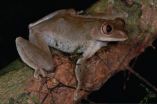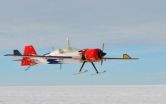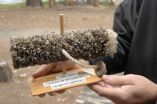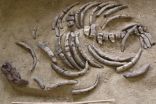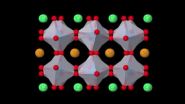(Press-News.org) COLLEGE PARK, MD - A new analytical tool adds human factors to a widely-used biological model of how animal populations interact, suggesting that human societies can reach a steady state that is sustainable when they do not over-deplete natural resources and avoid extreme economic inequality.
The paper, titled "Human and nature dynamics (HANDY): modeling inequality and use of resources in the collapse or sustainability of societies," was published in the May 2014 issue of the journal Ecological Economics. Its authors are Safa Motesharrei, a Ph.D. candidate in applied mathematics at UMD; Jorge Rivas of the Institute of Global Environment and Society; and Eugenia Kalnay, Distinguished University Professor in the Department of Atmospheric and Oceanic Science and the Institute for Physical Science and Technology at UMD.
Kalnay, an internationally recognized weather and climate scientist, worked in leadership positions at NASA and the National Oceanic and Atmospheric Administration (NOAA) for two decades and currently serves on the UN Secretary General's Scientific Advisory Board on Sustainability. She is renowned, in part, for leading the National Weather Service's advances in weather modeling in the 1990s. Her recent work has focused on advancing understanding of climate change and environmental sustainability through improved modeling of the coupled interaction of earth and human systems.
HANDY's starting point is a well-known model in biology and population ecology, commonly known as the "predator-prey model," which is used to understand the dynamics of animal populations. The researchers applied that model's concepts to human societies, and incorporated two new variables that are not included in existing models: accumulation of wealth and economic stratification between rich and poor. These changes are necessary, the researchers say, to reflect that some segments of human society use more resources than others, and accumulated wealth can delay, but not prevent, the decline that occurs when a population exceeds the carrying capacity of its environment. With HANDY, the researchers say, they have developed a practical method for using the relevant natural, social and economic conditions to estimate a human society's carrying capacity.
While some HANDY scenarios are suggestive of past civilizations that flourished and then collapsed, such as the ancient Romans and Mayans, the model was not created to explain specific societies' collapse, team members said.
The model is "not intended to describe actual individual cases" – such as modern Western society – "but rather to provide a general framework that allows carrying out 'thought experiments' for the phenomenon of collapse and to test changes that would avoid it," the authors wrote in the research paper.
"The model does not say that society's collapse is imminent," said Rivas, "nor does it predict a collapse for 'Western' or 'industrial' civilization despite some pre-publication reports to the contrary."
"HANDY is not a forecasting model," Motesharrei said. "It cannot be used to predict the future of any society. It can, however, help us understand the possible underlying mechanisms in the evolution of a society."
This minimal modeling approach focuses on the long-term behavioral properties of dynamical systems, the authors explain. The goal is not to find precise solutions for the variables of the real system, but instead to address questions such as:
In the long run, will the system settle at a steady state?
What are these possible steady states?
What factors determine which long-term behavior is followed?
"The results of our model are optimistic, because they show that by making certain decisions, we can bring about a sustainable future," said Rivas. Unlike physical and natural systems, such as the solar system or an ecosystem, "we can, as humans, make critical choices that can change the long-term path that our social system will take, and we can optimize such choices using scientific models. This is a key takeaway lesson of this paper."
However, the model shows that "if we continue to over-deplete nature, and if inequality continues such that the rich consume far more than the poor, the system eventually collapses," Kalnay said.
INFORMATION:
A copy of the published paper is available for download here: http://www.sciencedirect.com/science/article/pii/S0921800914000615
Motesharrei received support for this study through the cooperative agreement between NASA Goddard Space Flight Center and the University of Maryland's Earth System Science Interdisciplinary Center (Award No. NNX12AD03A) to develop a coupled human-earth system model, including the mathematical development of the HANDY model.
University of Maryland
Media contacts:
Heather Dewar
301-405-9267
hdewar@umd.edu
Lee Tune
301-405-4679
ltune@umd.edu
New model shows moderate resource use & reduced economic inequality keys to sustainability
2014-04-02
ELSE PRESS RELEASES FROM THIS DATE:
One or 2? How to decide how many species you have got
2014-04-02
It is often difficult to decide whether two animals belong to the same or two distinct species. This can be especially challenging for animals which externally look very similar. In a recent study, published in the open access journal Zoosystematics and Evolution, scientists from the Museum für Naturkunde Berlin use genetic data and sound analysis to test if treefrogs from West and Central Africa belong to different or the same species.
Due to the fact that, when external characters are used, only size is useful to distinguish these frogs the scientists employed additional ...
Remotely operated aircraft successfully tested as tool for measuring changes in polar ice sheets
2014-04-02
Scientists studying the behavior of the world's ice sheets--and the future implications of ice sheet behavior for global sea-level rise--may soon have a new airborne tool that will allow radar measurements that previously would have been prohibitively expensive or difficult to carry out with manned aircraft.
In a paper published in the March/ April edition of IEEE Geoscience and Remote Sensing Magazine, researchers at the Center for Remote Sensing of Ice Sheets (CReSIS) at the University of Kansas noted that they have successfully tested the use of a compact radar system ...
Don't move a mussel (or a clam, or a snail)
2014-04-02
(Millbrook, NY) Anyone that has spent time at a seaside pier has witnessed the destruction barnacles wreak on boat hulls. But biofouling animals are not limited to marine environments. A new paper published in the journal Frontiers in Ecology and the Environment estimates that the global management of freshwater mussels, clams, and other clinging animals costs $277 million U.S. dollars annually.
Biofoulers are organisms that accumulate underwater on hard surfaces, to the detriment of property and economically important activities, such as shipping, power generation, ...
Beyond proficiency: How early English exposure influences non-native speakers
2014-04-02
PRINCETON, N.J.—Non-native speakers exposed to English before moving to America are more likely to use the language in their daily lives in the United States, according to a report led by Princeton University's Woodrow Wilson School of Public and International Affairs.
Such early exposure – through newspapers, books, TV and classes as well as traveling – may help determine an immigrant's socioeconomic mobility, as English proficiency is strongly tied to cultural and social assimilation. The report, featured in the journal Social Science Research, is one of the first ...
Americans using more energy according to Lawrence Livermore analysis
2014-04-02
Americans used more renewable, fossil and even nuclear energy in 2013, according to the most recent energy flow charts released by Lawrence Livermore National Laboratory.
Each year, the Laboratory releases energy flow charts that illustrate the nation's consumption and use of energy. Overall, Americans used 2.3 quadrillion thermal units more in 2013 than the previous year.
The Laboratory also has released a companion chart illustrating the nation's energy-related carbon dioxide emissions. Americans' carbon dioxide emissions increased to 5,390 million metric tons, ...
Killing a name of an extinct sea cow species
2014-04-02
Sirenians, or sea cows, are a particular group of mammals that superficially resembles whales in having, amongst other features, a streamlined-body and horizontal tail fluke. Though belonging to the so-called marine mammals, such as whales and seals, sea cows are members of a group having a single origin that includes their closest living relatives, the proboscideans (or elephants in the broader sense).
Today, sirenians are known by only four species, but their fossil record is much more diverse documenting the transition from land-dwelling animals to fully aquatic ones. ...
Ethics guidelines for next generation of risky NASA missions
2014-04-02
MEDIA ADVISORY: Institute of Medicine Committee to Report on Ethical Guidelines For Health Standards on Next Generation of NASA Missions: Long Duration and Exploration Spaceflights
WHEN: Embargoed until Wednesday April 2, 2014 11:00 AM EDT
WHAT: Spaceflights beyond low earth orbit or lasting longer than 30 days, including extended stays on the International Space Station and missions to Mars, will likely expose astronauts to increased and even unknown levels of risk, and therefore would not meet NASA's current health standards. The space agency commissioned a report ...
Intelligent warning systems may make 'dilemma zone' safer
2014-04-02
Most drivers have experienced a traffic signal that turns yellow just as they approach an intersection, which makes it difficult for them to decide whether to stop or proceed through it. The wrong choice in this critical situation, known as the "dilemma zone," may lead to crashes, especially at high-speed intersections. A new study published in Human Factors examines how intelligent warning systems help drivers negotiate the dilemma zone and encourage safer driving behavior.
"Intelligent systems could improve driver safety by potentially reducing crashes at signalized ...
Longer stay in hospital ICU has lasting impact on quality of life
2014-04-02
Patients have substantial physical impairments even two years after being discharged from the hospital after a stay in an intensive care unit (ICU), new Johns Hopkins research suggests.
The scientists found that for every day of bed rest in the ICU, muscle strength was between 3 and 11 percent lower over the following months and years.
"Even a single day of bed rest in the ICU has a lasting impact on weakness, which impacts patients' physical functioning and quality of life," says Dale M. Needham, M.D., Ph.D., an associate professor of medicine and of physical medicine ...
Drexel researchers open path to finding rare, polarized metals
2014-04-02
VIDEO:
Researchers in Drexel's College of Engineering have discovered a way to classify and predict the existence of a rare breed of electrically conductive polar metals.
Click here for more information.
PHILADELPHIA - Drexel University researchers are turning some of the basic tenets of chemistry and physics upside down to cut a trail toward the discovery of a new set of materials. They're called "polar metals" and, according to many of the scientific principles that govern the ...
